Historiske britiske landskaber under alvorlig trussel fra klimakrise
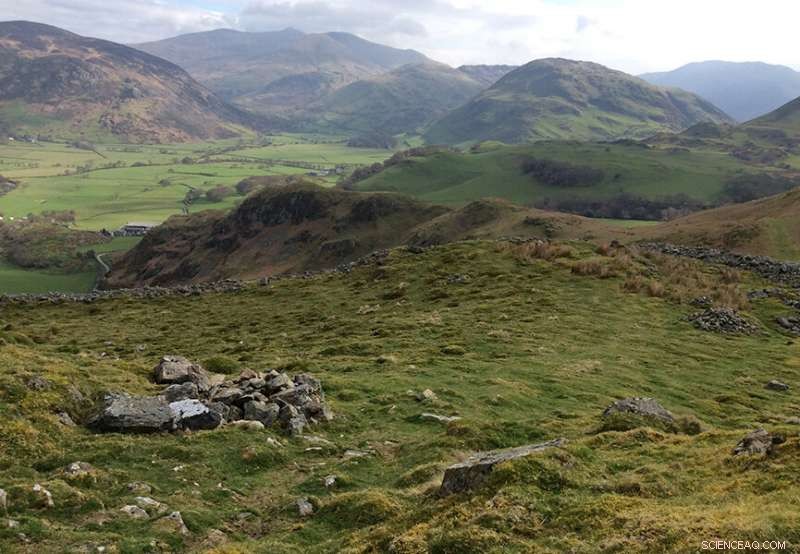
Dysynni-dalen i Wales, som er hjemsted for resterne af post-middelalderlige landbrugsaktiviteter, der omfatter tørstensvægge. Tørstensvægge er et nøgleelement i den historiske karakter af landskabet i Dysynni-dalen, men også på tværs af resten af Snowdonia, Lake District, og Peak District. Skiftende vejrforhold, varmere temperaturer og længere vækstsæsoner, betyder, at vegetationstypen i dette område kan ændre sig, buske eller træer kan vokse over resterne, slører dem og ændrer landskabets historiske karakter. Kredit:University of Sheffield
Nogle af Storbritanniens mest elskede historiske landskaber, såsom Lake District, Snowdonia og Orkneyøerne risikerer at blive alvorligt beskadiget og forandret for altid af virkningerne af klimaændringer, ifølge en arkæolog fra University of Sheffield.
Forskning af Isabel Cook, en ph.d. studerende fra Universitetets Arkæologiske Institut, føjer til det voksende bevis på, at historiske landskaber i hele Storbritannien allerede er blevet påvirket af klimaændringer, såsom havniveaustigning, kysterosion og oversvømmelser.
Blandt de berørte historiske landskaber er Dysynni-dalen i Wales, som er hjemsted for militære rester fra Anden Verdenskrig. Isabels forskning har fundet ud af, at området er i fare for havniveaustigning og oversvømmelser, med resterne under alvorlig trussel om erosion.
Tidligere undersøgelser har vist, at historiske steder såsom Forts of the Saxon Shore, en samling af romerske kystfæstninger, der strækker sig langs Englands sydøstlige kyst og omfatter funktioner ved Dover Castle, Pevensey Castle og Burgh Castle, har været påvirket i varierende grad af kystnære processer som erosion og jordskred. Nogle af de saksiske kystforter er gået helt tabt på grund af erosion, såsom dem på Walton Castle i Suffolk.
Den lille by Dunwich, som var et stort center for middelalderlig skibsbygning og handel på Suffolk-kysten i det 14. århundrede, har set sin kystlinje trække sig tilbage med 600 meter - noget som fuldstændig har ødelagt byens kulturelle arv og historiske karakter. Ti kirker og et kloster er gået tabt der indtil videre, med erosion, der fortsat truer resten af området.
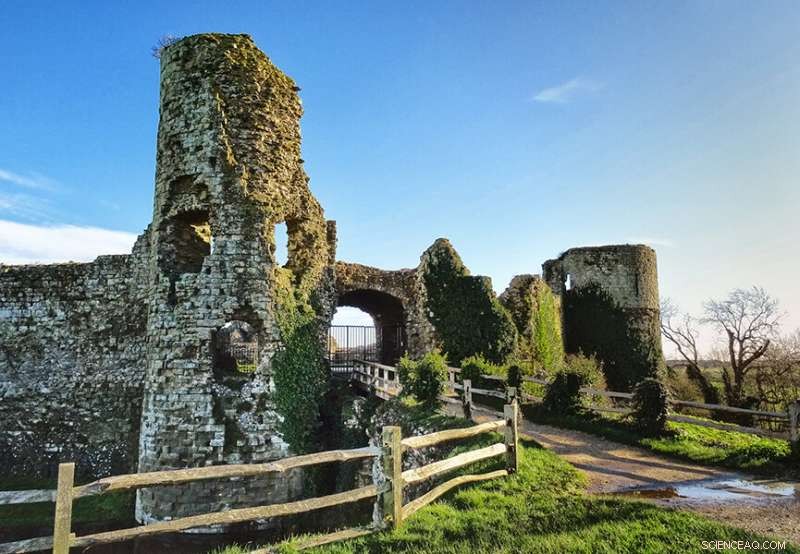
Pevensey Castle har funktioner, der er en del af Forts of the Saxon Shore - en samling af romerske kystfæstninger, der er blevet påvirket i varierende grad af kystprocesser såsom erosion og jordskred. Kredit:University of Sheffield
Isabels forskning afslører, hvordan tabet i Dunwich ikke kun relaterer sig til forsvinden af individuelle bygninger og steder i isolation, men også til tabet af byens arv og bylandskabets historiske karakter.
Med truslen mod Dysynni Valley, tabene på den sydøstlige kyst og de seneste nyheder om, at stigende hav og øget nedbør truer Orkneyøernes verdensarvsstatus, Arkæologen fra University of Sheffield opfordrer nu til mere handling for at beskytte Storbritanniens historiske landskaber, som hun understreger er "levende museer."
Isabel sagde:"Landskaber er enormt vigtige for kulturarven, ikke bare i Storbritannien, men i alle lande rundt om i verden. De er dynamiske rum, der rummer nationens arv og historie, mens de fungerer som turistattraktioner og understøtter landbrugsindustrien. De er steder. som vi interagerer med, og leve indeni, danner konteksten for vores liv, levebrød og minder. Dette gør landskaber ekstremt vigtige for kulturel identitet, så vi skal være opmærksomme på den meget reelle trussel, de står over for fra virkningerne af klimaændringer.
"Der bliver allerede truffet foranstaltninger for at forsøge at beskytte vigtige historiske monumenter, men vi er nødt til at indse, at betydelige landskaber også er i fare for klimaændringer.
"Forestil dig et Storbritannien, hvor de historiske gader og promenader i victorianske kystbyer som Brighton, Bournemouth og Aberystwyth bliver sløret af hårde kystforsvar bygget for at beskytte hjem og virksomheder mod erosion, stigende havniveauer og ekstreme oversvømmelser. Forestil dig et Storbritannien, hvor prydhaverne i historiske godser, som Chatsworth i Derbyshire og Cragside i Northumberland, udryddes af nye invasive arter, skadedyr, og sygdomme, og hærget af tørke. Vi skal sikre, at vores børnebørn og deres børnebørn kan opleve og lære af disse steder, som vi har gjort."
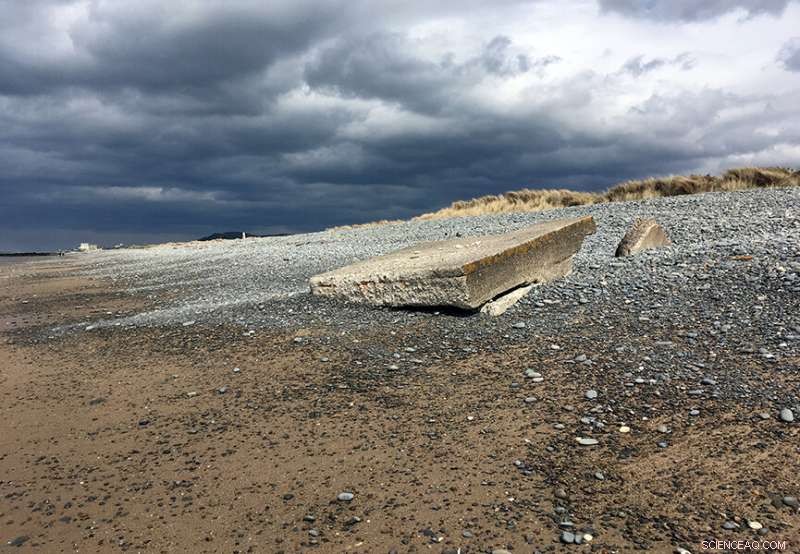
En kollapset WWII pilleæske på Aberdyfi-stranden. Dette område har en vigtig forbindelse med Storbritanniens militærhistorie, med en RAF-base placeret her indtil 1945, da det blev til en hærbase. Der er også skydebaner i nærheden, og flere kendte flystyrtsteder i de omkringliggende bakker. Increasing storminess and coastal erosion will accelerate the demise of these features which connect the area to an important part of history that is still within living memory. Kredit:University of Sheffield
While heritage agencies are beginning to acknowledge and take steps towards addressing the threat posed by climate change to historic buildings, monuments and sites, research by the University of Sheffield archaeologist reveals how little is being done to protect the landscape itself.
English Heritage has published a risk assessment on the threat of coastal erosion to its estate and the Shifting Shores report looks at the potential impact of climate change on National Trust properties. Although these reports mention the landscape setting of heritage sites, Isabel's research highlights how they do not specifically mention the threat to the historic landscape.
Research by the Sheffield Ph.D. student also reveals how most previous academic studies into the impact of climate change on archaeological remains omit any mention of historic landscapes.
Som svar, Isabel has developed a framework for including historic landscapes in climate change impact, adaptation and mitigation research. This includes assessing how vulnerable historic landscapes are to the effects of climate change.
The framework also establishes a sustainability assessment methodology for coastal and flood-risk management that includes historic landscapes as a consideration—something which could be used by policy-makers to include the historic character of the landscape in climate change adaptation decisions. This could change the way that coastal erosion and flood-risk management is carried out in the future, with more consideration of the historic landscape alongside environmental, social and economic factors.
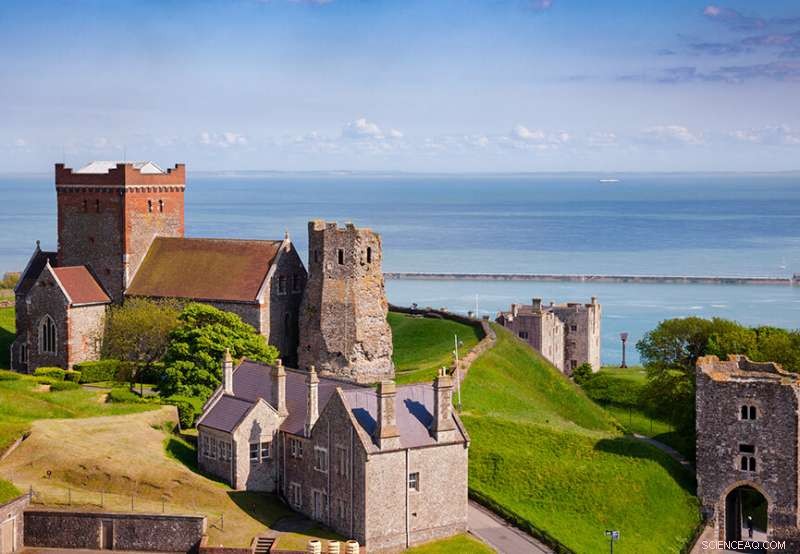
Roman lighthouse and St Mary de Castro church at Dover Castle. The castle also includes features that are part of the Forts of the Saxon Shore. Kredit:University of Sheffield
The Sheffield Ph.D. student's research also highlights how changes in temperatures and rainfall caused by climate change are likely to affect the distribution and behavior of plants and animals on important historical landscapes. Examples include the expansion of insect species towards higher latitudes and increased over-winter survival, which poses a greater risk of insect attack or bioturbation on important archaeological landscapes and remains.
Changing climatic conditions may also lengthen crop growing seasons and force people to grow food in different places, such as areas of important historical and cultural interest. For eksempel, arable crop farming may become an option in areas once only suitable for extensive sheep farming. As well as affecting local economies and traditional ways of life, this change could affect the visual character of historically important landscapes, ifølge undersøgelsen.
Historic woodland, parks and gardens, which characterize many historic landscapes, are also likely to be affected by changing temperatures and invasive species. This may affect the plants that can be grown in parks and gardens, and alter the ecosystems structure of ancient woodlands.
Derudover the University of Sheffield study highlights how the impact of climate change on historic landscapes is not limited to direct impacts—there may be impacts caused by the mitigation and adaptive approaches that are taken in response to climate change. For eksempel, the construction of coastal defenses in response to rising sea levels could result in a coastal squeeze, causing the loss of saltmarsh and beach.
Coastal defenses can also significantly alter the character of the coastline, affecting visual amenity. The Sheffield archaeologist is calling for the impact of coastal defenses on the historic landscape as a whole to be considered, rather than just the impact on individual archaeological sites.
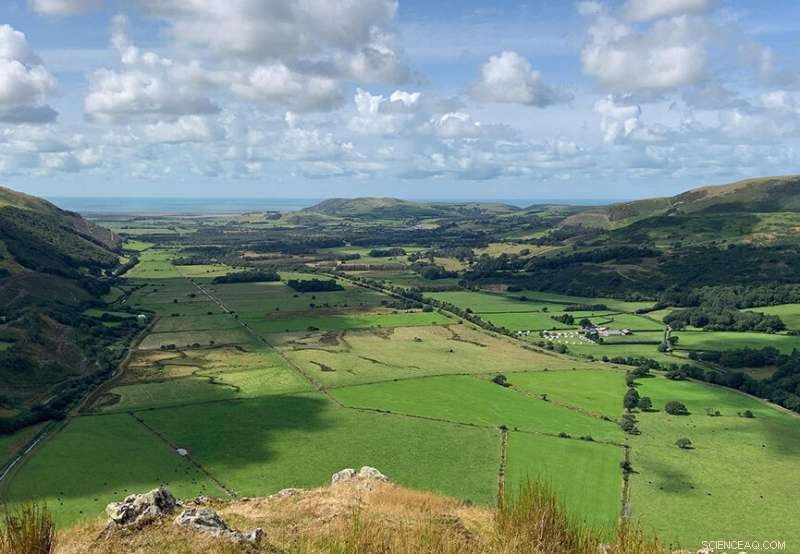
Birds Rock in the middle of the Dysynni Valley. Isabel's research indicates that, under a medium-emission scenario, all of the low-lying land pictured here would be under the mean high tide mark. This means that most of it would become unsuitable for any agricultural uses, and it may turn into wetland. This would be vary detrimental to the local economy, which is heavily reliant on the pastoral agriculture industry. Kredit:University of Sheffield
Isabel added:"A great wealth of archaeological material can be found on the British coastline and is now vulnerable to changing coastal processes that are being triggered by climate change.
"We've already seen coastal erosion and landslides—which are projected to worsen due to sea-level rise and increasing storminess—destroy many historic and prehistoric coastal fortifications and settlements on the south east coast of England. The loss of these features threatens the historic character of these coastal landscapes, be it a military and defensive landscape, a religious and early Christian landscape, or a landscape characterized by post-medieval trade and industry. We need to ensure that the historic landscape is factored into all climate change impact and adaptation research and management in the UK, at all stages of policy development and planning, rather than being considered only by heritage agencies.
"The framework developed through my research provides a simple method for establishing the different ways in which the character of each historic landscape is vulnerable to climate change. It also gives planners and policy-makers a useful tool for assessing the various ways in which different coastal and flood-risk management approaches will impact the historic landscape."
 Varme artikler
Varme artikler
-
 På vej mod bedre prognoser for fliseskredEPFL-forskere har udviklet en ny model, der vil forbedre forudsigelsen af plaque-lavinerisiko. Kredit:EPFL Et team af forskere fra EPFL og SLF har udviklet en ny model, der beskriver, hvordan pl
På vej mod bedre prognoser for fliseskredEPFL-forskere har udviklet en ny model, der vil forbedre forudsigelsen af plaque-lavinerisiko. Kredit:EPFL Et team af forskere fra EPFL og SLF har udviklet en ny model, der beskriver, hvordan pl -
 Alaska bager under hedebølge forbundet med klimaændringerMarts 2019 kan vise sig at blive den varmeste marts nogensinde, mange steder i Alaska, med temperaturer for nogle nordlige byer og byer, der potentielt stiger 25 til 40 grader Fahrenheit over normalen
Alaska bager under hedebølge forbundet med klimaændringerMarts 2019 kan vise sig at blive den varmeste marts nogensinde, mange steder i Alaska, med temperaturer for nogle nordlige byer og byer, der potentielt stiger 25 til 40 grader Fahrenheit over normalen -
 Sjov High School Science ExperimentsSe stille og passivt at se de samme gamle eksperimenter, som de har gjort siden mellemskolen, ikke vil hjælpe gymnasieelever til at deltage i science curriculum. Uanset om du underviser i biologi, kem
Sjov High School Science ExperimentsSe stille og passivt at se de samme gamle eksperimenter, som de har gjort siden mellemskolen, ikke vil hjælpe gymnasieelever til at deltage i science curriculum. Uanset om du underviser i biologi, kem -
 NASA målte nedbør fra Fehis-rester i New ZealandDen 31. januar kl. 1725 UTC (1. februar kl. 6:25 NZDT) så GPM regn bevæge sig ud på kysten af New Zealands Sydø og ekstremt kraftig nedbør i en intens stormvejr sydvest for stormens centrum over det
NASA målte nedbør fra Fehis-rester i New ZealandDen 31. januar kl. 1725 UTC (1. februar kl. 6:25 NZDT) så GPM regn bevæge sig ud på kysten af New Zealands Sydø og ekstremt kraftig nedbør i en intens stormvejr sydvest for stormens centrum over det
- Konservative bestyrelser er mere tilbøjelige til at afskedige CEO
- Hvordan man kan slippe af med Grackles
- Søværnets bestræbelser på at beskytte hvaler har begrænset effekt
- Billede:Solar array drivmekanisme på mikrovibrationsenhed
- Tysklands Infineon køber Cypress i en aftale på 9 milliarder euro
- Teknisk Q&A:Hvordan en netbank ved, hvem du er


